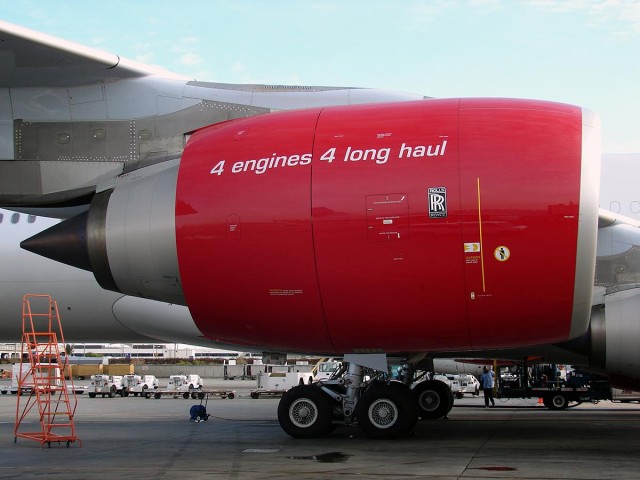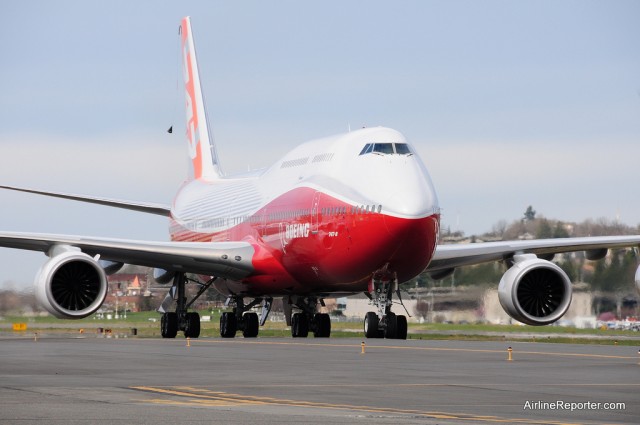There are few who can make a case against the Boeing 747 as the most majestic and beautiful airliner in the sky. I love the 747 (any variant) for its unique shape and instant recognition; you just won’t find folks lining up to tell you about the classic lines of the A380. Originally released in 1970, the Queen of the Skies has defined the term “jumbo jet” for multiple generations. But, despite the 747′s 40+ years as a long-haul mainstay for airlines around the world, is the future of the 747 and its latest variant, the 747-8, in jeopardy?
The Fiero Problem
The issue doesn’t seem to be that the 747 has gotten stale in its old age (in fact, Boeing’s latest version features new engines, a redesigned wing, a fuselage stretch, and advanced avionics; some might argue that Boeing spent WAY too much capital on a plane with so few orders). Rather, the problem seems to be that other planes have gotten so much better. This reminds me of that 80′s darling, the Pontiac Fiero, and its cool uncle, the Chevrolet Corvette.
GM and Pontiac built the Fiero from 1984-1988. A mid-engined, two-seater sports car with sharp (for the 80′s) looks, the Fiero did a lot of things well that the Corvette also was known for. Although not officially acknowledged by GM as a reason for ending the program, enthusiasts maintain that GM killed the Fiero because it was encroaching on the performance envelope of the ‘Vette, at lower acquisition and operating costs. Sound familiar? If you’ve ever flown on a Boeing 777, it should.

4 Engines 4 Long Haul. Makes sense, but takes gas. Image by SpeedbirdHD.
4 Engines 4 Long Haul
Sir Richard Branson and his Virgin Atlantic airline famously used this slogan to promote their fleets of A340 and 747 four-engine airliners. The thinking was that the flying public would be more comfortable crossing the pond with three engines to spare. Unfortunately, jet fuel prices have raised obscenely over the past two decades (nearly 500%) and twin-engine airliners such as the Boeing 777 and Airbus A330 have proven so reliable, what with their ETOPS (Extended range Twin Operations) ratings, that they have rendered all but the largest four-engine planes uneconomical. Recently, both Airbus and Boeing have been buying back A340 jets as compensation for new jet deals. While 747-400s still generally have an afterlife in cargo service (versus the A340) we’ve seen Boeing become the biggest buyer of used 744s recently. Think of it like Chevy giving “current owner” incentives when you trade in your late-model Silverado pickup for a new model.
The Replacement Players
Recently, United Airlines announced a purchase of 35 Airbus A350-1000 jets. While some have argued this is a replacement for their aging Boeing 747-400 fleet, I disagree. The A350-1000 has the range for the routes that the 744 is used on (primarily to Asia and Australia), but it won’t have the capacity. While it’s hard to know exactly how United will configure the A350, a quick look at the stats gives us some hints. The A350-1000 is slated to be exactly the same length as the 777-300ER, and will be a tad bit narrower. American Airlines recently started flying the 773 and in their four-class layout it seats 310 passengers. United’s 744 seats 376, so best guess is that United’s A350 will be about a 20% capacity drop on high-traffic routes such as San Francisco (SFO) to Hong Kong (HKG).
If United’s new A350-1000s can’t “replace” their 747-400 fleet, what can? The new 777-9X. Or as I like to call it, the 777 Fiero.
And what about the Airbus A380? I’m not suggesting that United needs that kind of a capacity boost, but how has the fat kid from Airbus fared? While firm orders for the A380 have exceeded the 747-8 (even with no freighter variant currently available), Airbus still needs a significant boost in orders to get close to making money on the bird. Without new orders for either jumbo, the backlog for both will run out at about the same time.
God Save the Queen
The future isn’t all bleak for the 747-8; it does have some things going for it. Personally, I’m hoping for an order from a certain government customer that has a beautiful blue and white livery.
BONUS: A Look at the First Boeing 747-400s to be Scrapped
The 747-8F is unique as a cargo hauler, with extreme range (especially after the aft tail fuel tank is certified) and an upper-deck cockpit that allows the giant nose to lift open. Unfortunately, the global slump in air cargo has been very untimely; there are sources reporting brand-new planes parked in the desert awaiting customers. Boeing recently slowed the assembly line from two planes per month to 1.75 to better meet demand. Right now the program seems to be limping along.
Back to the Future
Boeing has a bit of time to let the global economy continue to recover and see what happens with the 747 line. At the current production rate of 1.75 planes per month (or 21 planes per year), booked orders will keep the line busy for at least three more years, assuming no additional orders. Domestically, I don’t think we’ll see any orders from the new American Airlines, who should be well set with their new 777-300ER fleet, but both Delta and United will need to find a true replacement for their 747-400 fleets. The future of the 747-8I will likely be telegraphed by the 777-X program launch; if we see large orders from current 744 operators, the writing will likely be on the wall.
Your Take?
Why do you think airlines haven’t adopted the 747-8I? Does it have a future? Let’s hear it!
 | Blaine Nickeson, Correspondent. Blaine is a Denver-based enthusiast of all things airplanes, airlines, and miles. When he’s not busy planning his next travel adventure, he spends his time working as a college administrator. If he can’t be on an airplane, he’d prefer to be on a bicycle. @bnickeson |
Other Stories of Interest
-
 Video: The Boeing 747 Family – From the 747SP to the 747-8
Video: The Boeing 747 Family – From the 747SP to the 747-8 -
 Airline Livery of the Week: Pullmantur Air & Their 747s
Airline Livery of the Week: Pullmantur Air & Their 747s -
 Denver, Dreamliner, Tokyo, Singapore, Hong Kong & Back in 77 Hours
Denver, Dreamliner, Tokyo, Singapore, Hong Kong & Back in 77 Hours -
 Epic AvGeek Photo: Dreamlifter Lands with AN-124 in Background
Epic AvGeek Photo: Dreamlifter Lands with AN-124 in Background -
 PHOTOS: The Wonderful Liveries of the Boeing 787 Dreamliner
PHOTOS: The Wonderful Liveries of the Boeing 787 Dreamliner -
 A Unique Video of Frankfurt Airport – It Looks Like a Model!
A Unique Video of Frankfurt Airport – It Looks Like a Model!


No comments:
Post a Comment